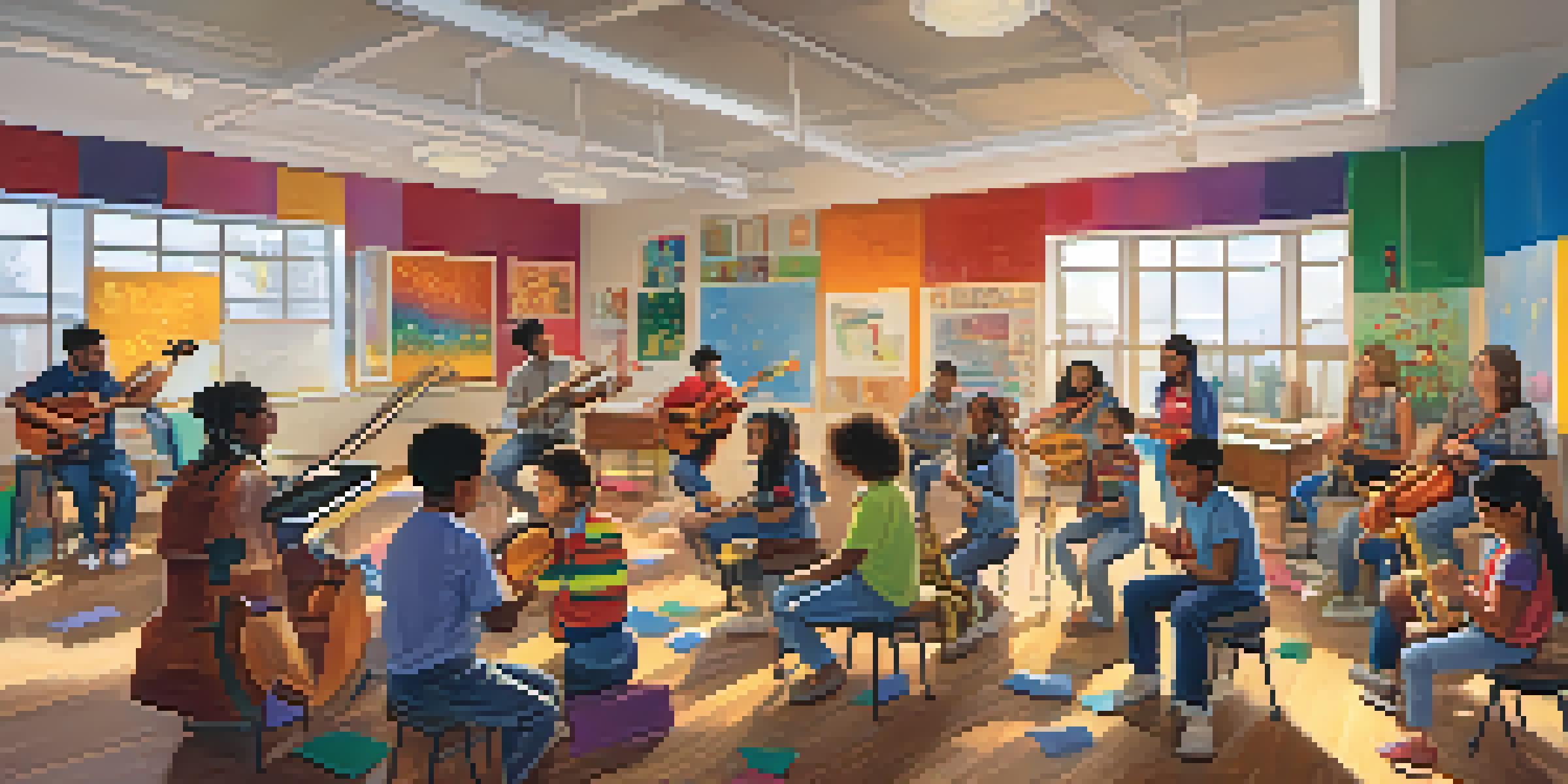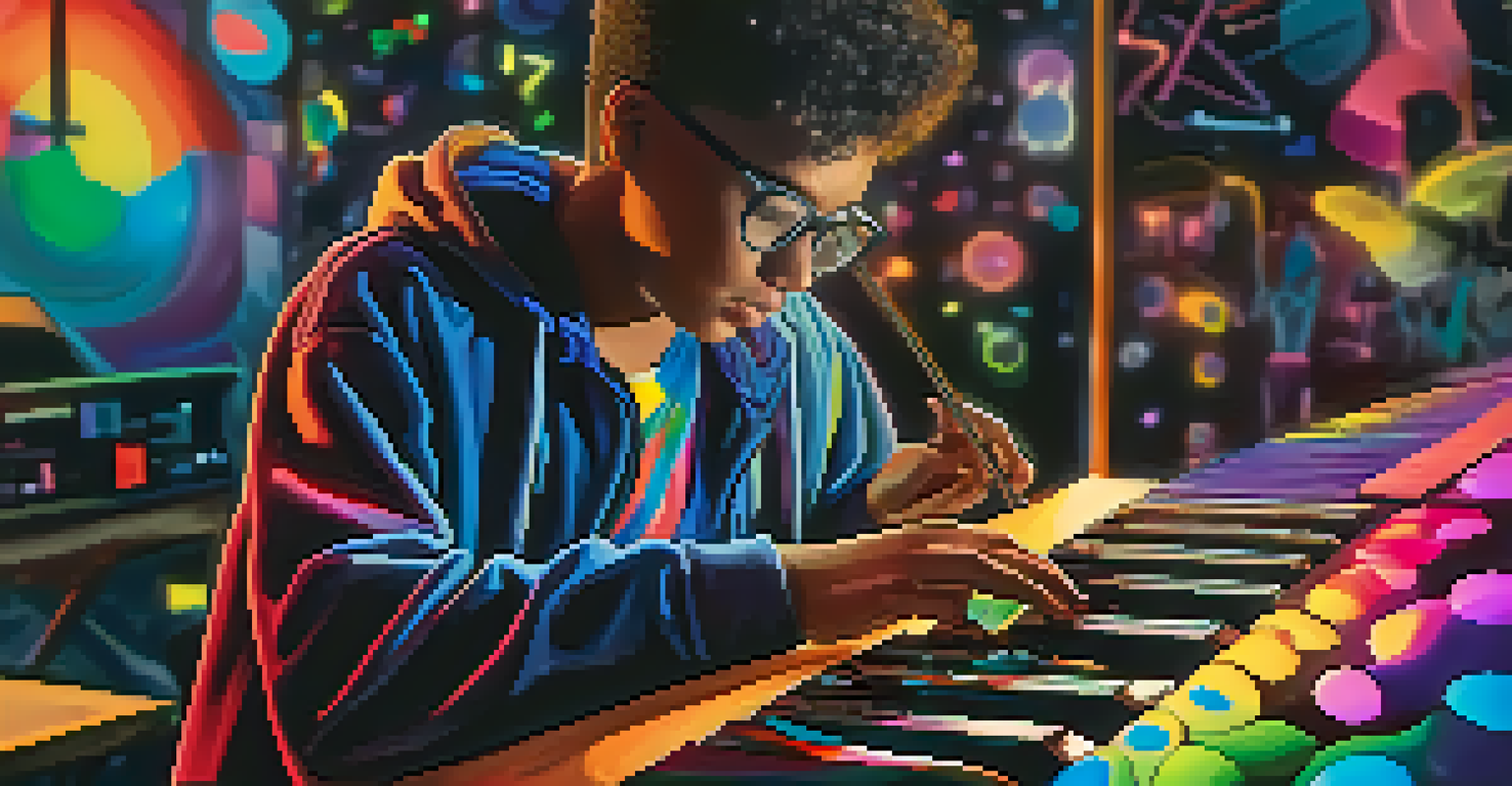Innovative Techniques for Teaching Music to Neurodiverse Learners

Understanding Neurodiversity in Music Education
Neurodiversity encompasses a range of neurological differences, including autism, ADHD, and dyslexia. When it comes to music education, understanding these differences is crucial for effective teaching. Each learner may have unique ways of processing music, which means a one-size-fits-all approach won't work.
Neurodiversity is not a limitation, but a difference that offers unique strengths and perspectives.
Recognizing and respecting these differences allows educators to tailor their methods to cater to individual needs. For instance, some neurodiverse learners may thrive in a structured environment, while others may benefit from more flexibility. By embracing this diversity, teachers can create a more inclusive and engaging music education experience.
Ultimately, understanding neurodiversity is the first step in developing innovative teaching techniques that resonate with all students. It sets the stage for exploring various methods that can enhance the learning process and foster a love for music.
Incorporating Multi-Sensory Approaches
Multi-sensory learning engages multiple senses to enhance the educational experience. For neurodiverse learners, this can mean integrating visual, auditory, and kinesthetic activities into music lessons. For instance, using colorful visuals, hands-on instruments, and movement can create a rich learning environment.

Imagine teaching rhythm by having students clap, stomp, and use colorful scarves to express beats. This kind of engagement not only makes learning fun but also reinforces the concepts through various channels. By tapping into different senses, educators can help students grasp complex musical ideas more easily.
Embrace Neurodiversity in Learning
Understanding neurodiversity allows educators to tailor their teaching methods to meet the unique needs of each student.
Incorporating multi-sensory approaches helps to cater to diverse learning styles, making music education more accessible. It also encourages students to express themselves creatively, fostering a deeper connection to the music they are learning.
Utilizing Technology for Enhanced Learning
Technology plays a significant role in modern education, and music is no exception. Tools like apps, software, and digital instruments can provide neurodiverse learners with personalized learning experiences. For example, apps that allow students to compose music can cater to their individual preferences and pace.
Music is the shorthand of emotion.
Moreover, technology can provide instant feedback, enabling students to assess their progress in real-time. This can be especially beneficial for learners who may struggle with traditional evaluation methods. By using technology, educators can create a dynamic learning environment that encourages exploration and creativity.
Incorporating technology into music education not only enhances engagement but also prepares students for a future where digital skills are essential. It opens up new avenues for expression and collaboration, making music more accessible to all.
Creating a Flexible Learning Environment
Flexibility in the learning environment can significantly impact neurodiverse students' success. A classroom that allows for movement, quiet spaces, and varied seating options can help students feel more comfortable. This adaptability can lead to increased focus and participation during music lessons.
For example, providing options for standing or sitting while playing instruments can help accommodate different needs. Additionally, creating a calming corner with sensory tools can offer students a break when they feel overwhelmed. This kind of environment encourages students to engage at their own pace and comfort level.
Utilize Multi-Sensory Techniques
Incorporating multi-sensory approaches can enhance music education by engaging various senses and catering to diverse learning styles.
By fostering a flexible learning space, educators can promote a sense of safety and belonging, crucial for neurodiverse learners. It allows them to express themselves freely and explore their musical talents without fear of judgment.
Incorporating Social Interaction and Collaboration
Music is inherently social, and incorporating collaborative activities can enhance learning for neurodiverse students. Group projects, ensemble performances, and peer-to-peer learning can provide valuable social interaction opportunities. These activities not only build musical skills but also strengthen communication and teamwork.
For instance, having students work together to create a group composition can encourage sharing ideas and respecting differing perspectives. This collaborative approach fosters a sense of community, allowing students to learn from one another while developing their unique musical voices. It can also help build friendships and support networks.
By emphasizing social interaction in music education, teachers can help neurodiverse learners develop essential life skills while enjoying the creative process. This not only enhances their musical journey but also contributes to their overall personal growth.
Employing Structured Lessons with Clear Goals
Structured lessons that outline clear goals can provide neurodiverse learners with the guidance they need. Having a defined framework helps students understand what to expect and how to achieve success. For instance, breaking down a music piece into manageable sections can make the learning process less overwhelming.
Incorporating visual aids, like charts or diagrams, can further clarify objectives and progress. This allows students to see their accomplishments along the way, which can be very motivating. Additionally, using consistent routines in lessons can help students feel secure and focused.
Foster Individual Expression in Music
Encouraging individual expression through music helps neurodiverse learners build confidence and connect personally with their musical journey.
By employing structured lessons with clear goals, educators can create a roadmap for success that caters to the needs of neurodiverse learners. This approach not only enhances learning outcomes but also instills a sense of achievement and confidence in their musical abilities.
Encouraging Individual Expression Through Music
One of the most beautiful aspects of music is its ability to express individual emotions and experiences. Encouraging neurodiverse learners to explore their musical preferences and styles can foster a deeper connection to the art form. This exploration can include improvisation, songwriting, or experimenting with different genres.
For example, giving students the freedom to create their own melodies or lyrics allows them to express their unique perspectives. This not only boosts their confidence but also emphasizes that there is no right or wrong way to create music. It empowers them to be authentic in their musical journey.

By promoting individual expression, educators can cultivate a love for music that resonates personally with each student. This approach not only enhances creativity but also supports emotional well-being, making music an enriching and therapeutic outlet.
Assessing Progress with Understanding and Sensitivity
Assessment in music education should be approached with sensitivity, especially for neurodiverse learners. Traditional grading methods may not accurately reflect a student's progress or abilities. Instead, using alternative assessment strategies, such as portfolios or self-assessments, can provide a more holistic view of a student's growth.
For instance, encouraging students to reflect on their learning journey and set personal goals allows them to take ownership of their progress. This can create a more positive learning environment where students feel valued and understood. It shifts the focus from grades to personal development.
By assessing progress with understanding and sensitivity, educators can build stronger relationships with their students. This approach not only fosters a supportive atmosphere but also promotes a lifelong love for music, encouraging students to continue their musical journeys with confidence.